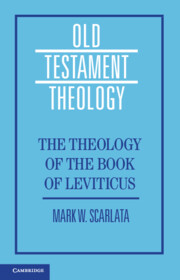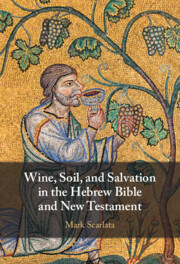Refine search
Actions for selected content:
93 results
1 - Liturgy in Early Christianity
- from Part I - Liturgy Throughout the Ages
-
-
- Book:
- The Cambridge Companion to Christian Liturgy
- Published online:
- 19 September 2025
- Print publication:
- 09 October 2025, pp 7-23
-
- Chapter
- Export citation
14 - Christology and the Eucharist
- from Part IIIa - Christology and Systematic Theology
-
-
- Book:
- The Cambridge Companion to Christology
- Published online:
- 15 September 2025
- Print publication:
- 02 October 2025, pp 234-250
-
- Chapter
- Export citation
Chapter 13 - Devotional Poetry
- from Part II - Forms and Genres
-
-
- Book:
- Michael Field in Context
- Published online:
- 03 October 2025
- Print publication:
- 25 September 2025, pp 114-122
-
- Chapter
- Export citation

The Cambridge Companion to Christian Liturgy
-
- Published online:
- 19 September 2025
- Print publication:
- 09 October 2025
7 - Theological Benefits of the Instrumental Doctrine
- from Part III - Theological Implications
-
- Book:
- The Humanity of Christ as Instrument of Salvation
- Published online:
- 21 August 2025
- Print publication:
- 04 September 2025, pp 201-225
-
- Chapter
- Export citation
Chapter 7 - Leviticus in the Old Testament and Beyond
-
- Book:
- The Theology of the Book of Leviticus
- Published online:
- 18 July 2025
- Print publication:
- 07 August 2025, pp 234-262
-
- Chapter
- Export citation

The Theology of the Book of Leviticus
-
- Published online:
- 18 July 2025
- Print publication:
- 07 August 2025
When Eucharists Attack: Discerning the Body in Cyprian’s On the Lapsed
-
- Journal:
- Harvard Theological Review / Volume 118 / Issue 3 / July 2025
- Published online by Cambridge University Press:
- 22 October 2025, pp. 486-503
- Print publication:
- July 2025
-
- Article
-
- You have access
- Open access
- HTML
- Export citation
7 - Sermons for Lent, Good Friday, and Easter
- from Part II - Augustine’s Sermons on the Scriptures and Liturgical Feasts
-
-
- Book:
- The Cambridge Companion to Augustine's Sermons
- Published online:
- 26 May 2025
- Print publication:
- 12 June 2025, pp 133-151
-
- Chapter
- Export citation
12 - Preaching on the Church’s Sacraments
- from Part III - Augustine’s Preaching Themes
-
-
- Book:
- The Cambridge Companion to Augustine's Sermons
- Published online:
- 26 May 2025
- Print publication:
- 12 June 2025, pp 226-244
-
- Chapter
- Export citation
5 - Sermons on the New Testament
- from Part II - Augustine’s Sermons on the Scriptures and Liturgical Feasts
-
-
- Book:
- The Cambridge Companion to Augustine's Sermons
- Published online:
- 26 May 2025
- Print publication:
- 12 June 2025, pp 98-115
-
- Chapter
- Export citation
Thomas Cranmer’s Appropriation of the Eucharistic Theology of Cyril of Alexandria: The Construction and Defence of a Reformed Agenda
-
- Journal:
- Journal of Anglican Studies , First View
- Published online by Cambridge University Press:
- 10 March 2025, pp. 1-15
-
- Article
- Export citation
7 - Rites of Marriage
- from Part III - Marriage Rites in Byzantine Liturgical Manuscripts
-
- Book:
- Marriage in Byzantium
- Published online:
- 01 May 2025
- Print publication:
- 23 January 2025, pp 241-309
-
- Chapter
- Export citation

Wine, Soil, and Salvation in the Hebrew Bible and New Testament
-
- Published online:
- 09 January 2025
- Print publication:
- 23 January 2025
14 - The Body of Jesus in His People
- from Part III - Ethics, Theology, and Critical Scholarship
-
-
- Book:
- The New Cambridge Companion to Jesus
- Published online:
- 15 November 2024
- Print publication:
- 05 December 2024, pp 232-249
-
- Chapter
- Export citation
Chapter 4 - Realist Liturgies
-
- Book:
- Liturgy, Ritual, and Secularization in Nineteenth-Century British Literature
- Published online:
- 14 November 2024
- Print publication:
- 21 November 2024, pp 100-126
-
- Chapter
- Export citation
Chapter 5 - Liturgical Aestheticism
-
- Book:
- Liturgy, Ritual, and Secularization in Nineteenth-Century British Literature
- Published online:
- 14 November 2024
- Print publication:
- 21 November 2024, pp 127-147
-
- Chapter
- Export citation
Epilogue
-
- Book:
- Liturgy, Ritual, and Secularization in Nineteenth-Century British Literature
- Published online:
- 14 November 2024
- Print publication:
- 21 November 2024, pp 165-170
-
- Chapter
- Export citation
Introduction
-
- Book:
- Theology and the Mythic Sensibility
- Published online:
- 07 November 2024
- Print publication:
- 21 November 2024, pp 1-12
-
- Chapter
- Export citation
Chapter 6 - Against Immanence
-
- Book:
- Liturgy, Ritual, and Secularization in Nineteenth-Century British Literature
- Published online:
- 14 November 2024
- Print publication:
- 21 November 2024, pp 148-164
-
- Chapter
- Export citation
